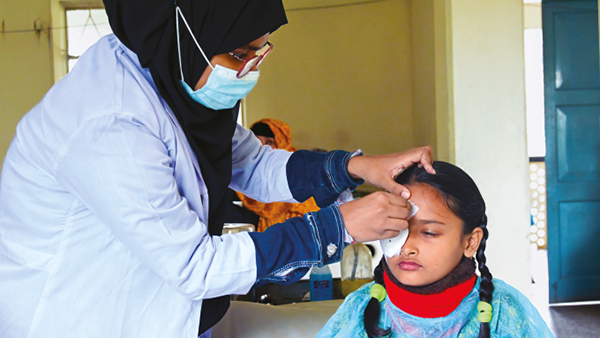You are viewing 1 of your 3 articles before login/registration is required
For Cataract Success, Get Ahead of DED
Preoperative treatment of DED and lid margin disease is absolutely essential, writes Kenneth A. Beckman
Studies show that most cataract patients have dry eye disease (DED), which can affect their surgical outcomes. In the oft-cited PHACO study, the authors showed that 77 percent of cataract patients had staining, 50 percent had central corneal staining, and nearly 63 percent had a tear breakup time (TBUT) of five seconds or less (1). These numbers ring true in my own practice, which is why I helped develop the ASCRS Preoperative OSD Algorithm to help us systematically detect and treat DED before surgery.
Preoperative treatment of DED and lid margin disease is absolutely essential in helping us meet three important goals:
- Prevent postoperative infection
- Obtain accurate measurements for IOL calculations
- Avoid postoperative aberrations that can result from an unstable ocular surface (particularly with multifocal lenses).
I explain these goals to patients every day so they understand why we need to spend a few weeks treating DED before surgery. It all begins with accurate screening for DED, which includes recognizing the unique symptoms of concurrent DED and cataracts.
Screening cataract patients for DED
The cataract workup includes refractive preoperative measurements. I get two sets of keratometry (K) readings, one manual and one with my biometry device, as well as topography. To help detect DED, I check the results for consistency, looking for incongruous K readings, irregular mires, or unusual topographies. If I find a problem, then we need to treat DED and repeat preoperative measurements later.
In addition, I get an accurate history. You can use a DED questionnaire, but I also choose to talk to cataract patients so I can differentiate between cataract-induced blurriness and fluctuating vision resulting from an unstable tear film. For example, patients might want cataract surgery because they “can’t read,” but when we talk about it, they say they’re able to read for an hour before their vision gets blurry. That’s an unstable tear film until proven otherwise.
For objective testing, I do a detailed slit lamp exam, including corneal staining. I carefully examine the lid margins, express the meibomian glands, and check the TBUT. I also rely on osmolarity to help detect DED and gauge its severity.
DED treatment and retesting
Cataract patients are eager to get their surgery, so I want the treatment plan to deliver rapid results. Everyone gets preservative-free artificial tears, which immediately helps to moisturize and lubricate the ocular surface without any detrimental preservatives. Drops that contain the lubricant povidone as well as hyaluronic acid (HA) and trehalose may be particularly useful. This combination has been shown to improve DED symptoms – including blurred vision – better than HA drops without trehalose (2).
In mild cases, artificial tears and lid hygiene (scrubs and warm compresses) are sufficient. If the lid margin disease is more advanced, I might do a short course of azithromycin or erythromycin. If there is staining or inflammation, I typically add a two-week course of a mild steroid, such as loteprednol or fluorometholone. I do not typically prescribe immunomodulators perioperatively because they take time to become effective; plus, I don’t want patients to have too many drops around the time of surgery. However, I do frequently recommend immunomodulators for long-term maintenance.
Patients return in two weeks. If their new K values and topography look good, we’re ready to choose an IOL. Occasionally, if I’m not confident that a patient will reliably manage their chronic DED after surgery, I might not recommend a multifocal or premium lens because they’d have vision problems months later without ongoing management of DED.
Classic case: DED changes refraction
A patient with cataracts was referred to me for toric IOLs to correct three diopters of astigmatism. My topographer verified the three diopters but, on close inspection, the mires had a divot at around 1 o’clock, so they weren’t circular. A red hot spot in the same area meant the topography didn’t reflect astigmatism’s classic bowtie. I found that the patient had a rapid TBUT, and there was evidence of moderate lid margin disease.
We treated the surface with preservative-free artificial tears and a two-week course of azithromycin as well as hygiene and warm compresses.
When the patient came back two weeks later, the hot spot was gone and the placido rings were more regular. Remarkably, the amount of astigmatism had dropped from 3 to 0.5 diopters. If I had selected a toric lens based on this patient’s initial measurements, he would be living very unhappily with 2.5 diopters of induced astigmatism. It’s a classic case that underscores just how much cataract outcomes depend on preoperative treatment for DED.
This article first appeared in The Ophthalmologist.
References
- WB Trattler, PA Majmudar et al., “The Prospective Health Assessment of Cataract Patients' Ocular Surface (PHACO) study: the effect of dry eye,” Clin Ophthalmol., 11, 1423 (2017). DOI:10.2147/OPTH.S120159
- F Chiambaretta, S Doan, et al., “A randomized, controlled study of the efficacy and safety of a new eye drop formulation for moderate to severe dry eye syndrome,” Eur J Ophthalmol., 27, 1 (2017).
The New Optometrist Newsletter
Permission Statement
By opting-in, you agree to receive email communications from The New Optometrist. You will stay up-to-date with optometry content, news, events and sponsors information.
You can view our privacy policy here
Most Popular
Sign up to The New Optometrist Updates
Permission Statement
By opting-in, you agree to receive email communications from The New Optometrist. You will stay up-to-date with optometry content, news, events and sponsors information.
You can view our privacy policy here
Sign up to The New Optometrist Updates
Permission Statement
By opting-in, you agree to receive email communications from The New Optometrist. You will stay up-to-date with optometry content, news, events and sponsors information.
You can view our privacy policy here







